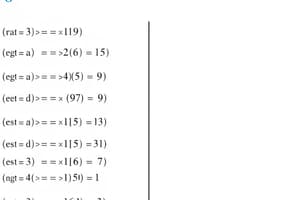Podcast
Questions and Answers
What is the primary focus of Discrete Mathematics?
What is the primary focus of Discrete Mathematics?
- Logical reasoning and proofs (correct)
- Continuous functions
- Differential equations
- Statistical analysis
Which logical connective is NOT commonly used in propositional logic?
Which logical connective is NOT commonly used in propositional logic?
- AND (∧)
- NOT (¬)
- OR (∨)
- EQUALS (=) (correct)
What is the result of the expression p → (q → r)?
What is the result of the expression p → (q → r)?
- p ∨ q ∨ r
- p ∧ q ∧ r
- p ∨ (q ∧ r)
- ¬p ∨ (¬q ∨ r) (correct)
What does propositional logic study?
What does propositional logic study?
What is the negation of the statement 'All birds can fly'?
What is the negation of the statement 'All birds can fly'?
Which of the following is an example of a tautology?
Which of the following is an example of a tautology?
What is a compound proposition?
What is a compound proposition?
Which of the following statements represents a contradiction?
Which of the following statements represents a contradiction?
In propositional logic, if p is true and q is true, what is the truth value of '¬(p ∧ q)'?
In propositional logic, if p is true and q is true, what is the truth value of '¬(p ∧ q)'?
What truth value does the statement 'If it is raining, then I get wet' have when it is not raining?
What truth value does the statement 'If it is raining, then I get wet' have when it is not raining?
What can be inferred from 'p → q' and '¬q'?
What can be inferred from 'p → q' and '¬q'?
Which logical operator has the highest precedence in propositional logic?
Which logical operator has the highest precedence in propositional logic?
What does the biconditional statement 'p ↔ q' signify?
What does the biconditional statement 'p ↔ q' signify?
Which of the following is NOT a characteristic of a minterm?
Which of the following is NOT a characteristic of a minterm?
If 'p' represents 'It is cold' and 'q' represents 'It is raining', what does 'p → q' imply?
If 'p' represents 'It is cold' and 'q' represents 'It is raining', what does 'p → q' imply?
Which type of proof entails deriving a contradiction from the assumption that a statement is true?
Which type of proof entails deriving a contradiction from the assumption that a statement is true?
Flashcards are hidden until you start studying
Study Notes
Discrete Mathematics Overview
- Primary focus is on logical reasoning and proofs.
- Important applications include computer science, cryptography, and mathematical logic.
Key Text
- "Discrete Mathematics and Its Applications" by Kenneth H. Rosen is a notable textbook in the field.
Propositional Logic
- Studies syntax, semantics, and inference rules.
- Key components include propositions, logical connectives, and types of statements.
Propositions
- Defined as declarative statements that can be classified as either true or false.
- Tautology example: "p ∨ ¬p" (always true).
- Contradiction example: "p ∧ ¬p" (always false).
Logical Connectives
- Common logical connectives include AND (∧), OR (∨), and NOT (¬).
- EQUALS (=) is not a logical connective.
Truth Values
- Truth value of "If it is raining, then I get wet" is true when it is not raining.
- "p → q" is true if p is false.
Logical Operators
- Negation (¬) has the highest precedence among logical operators.
- The contrapositive of "If p, then q" is "If not q, then not p."
Inference Forms
- Valid forms of inference include Modus Ponens, Modus Tollens, and Hypothetical Syllogism.
Compound Propositions
- Formed by combining two or more propositions.
- Example of a well-formed formula: "p → q ∧ r".
Quantifiers
- Existential quantifier (∃) indicates "there exists at least one".
- The negation of "All cats have tails" is "At least one cat does not have a tail".
Proof Methods
- Methods include direct proof, indirect proof, and proof by contradiction.
Logical Equivalence
- Maintains properties such as reflexivity, symmetry, and transitivity.
- Example of valid equivalence: "p → q ≡ ¬p ∨ q".
Minterms and Logical Structures
- A minterm is identified as a product of variables.
- The result of "¬(p ∨ q)" is equivalent to "¬p ∧ ¬q".
Logical Implication
- Refers to the relationship between two propositions, showing dependency.
Rules of Inference
- Includes rules like Modus Ponens, Modus Tollens, and Disjunctive Syllogism.
- Conditional proof is not classified as a rule of inference.
Well-Formed Formulas (WFF)
- A formula follows the rules of syntax; it is not inherently true or false.
Studying That Suits You
Use AI to generate personalized quizzes and flashcards to suit your learning preferences.




